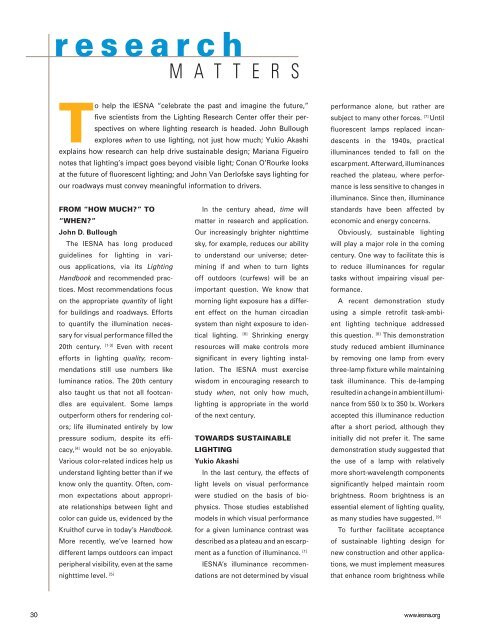COMMeMOratiVe ISSue - Illuminating Engineering Society
COMMeMOratiVe ISSue - Illuminating Engineering Society
COMMeMOratiVe ISSue - Illuminating Engineering Society
You also want an ePaper? Increase the reach of your titles
YUMPU automatically turns print PDFs into web optimized ePapers that Google loves.
e s e a r c h<br />
M A T T E R S<br />
To help the IESNA “celebrate the past and imagine the future,”<br />
five scientists from the Lighting Research Center offer their perspectives<br />
on where lighting research is headed. John Bullough<br />
explores when to use lighting, not just how much; Yukio Akashi<br />
explains how research can help drive sustainable design; Mariana Figueiro<br />
notes that lighting’s impact goes beyond visible light; Conan O’Rourke looks<br />
at the future of fluorescent lighting; and John Van Derlofske says lighting for<br />
our roadways must convey meaningful information to drivers.<br />
From “How much” to<br />
In the century ahead, time will<br />
“When”<br />
matter in research and application.<br />
John D. Bullough<br />
Our increasingly brighter nighttime<br />
The IESNA has long produced sky, for example, reduces our ability<br />
guidelines for lighting in various<br />
applications, via its Lighting mining if and when to turn lights<br />
to understand our universe; deter-<br />
Handbook and recommended practices.<br />
Most recommendations focus important question. We know that<br />
off outdoors (curfews) will be an<br />
on the appropriate quantity of light morning light exposure has a different<br />
effect on the human circadian<br />
for buildings and roadways. Efforts<br />
to quantify the illumination necessary<br />
for visual performance filled the tical lighting. [6] Shrinking energy<br />
system than night exposure to iden-<br />
20th century. [1-3] Even with recent resources will make controls more<br />
efforts in lighting quality, recommendations<br />
still use numbers like lation. The IESNA must exercise<br />
significant in every lighting instal-<br />
luminance ratios. The 20th century wisdom in encouraging research to<br />
also taught us that not all footcandles<br />
are equivalent. Some lamps lighting is appropriate in the world<br />
study when, not only how much,<br />
outperform others for rendering colors;<br />
life illuminated entirely by low<br />
of the next century.<br />
pressure sodium, despite its efficacy,<br />
[4] would not be so enjoyable. Lighting<br />
Towards Sustainable<br />
Various color-related indices help us Yukio Akashi<br />
understand lighting better than if we In the last century, the effects of<br />
know only the quantity. Often, common<br />
expectations about appropri-<br />
were studied on the basis of bio-<br />
light levels on visual performance<br />
ate relationships between light and physics. Those studies established<br />
color can guide us, evidenced by the models in which visual performance<br />
Kruithof curve in today’s Handbook. for a given luminance contrast was<br />
More recently, we’ve learned how described as a plateau and an escarpment<br />
as a function of illuminance. [1]<br />
different lamps outdoors can impact<br />
peripheral visibility, even at the same IESNA’s illuminance recommendations<br />
are not determined by nighttime level. [5]<br />
visual<br />
performance alone, but rather are<br />
subject to many other forces. [7] Until<br />
fluorescent lamps replaced incandescents<br />
in the 1940s, practical<br />
illuminances tended to fall on the<br />
escarpment. Afterward, illuminances<br />
reached the plateau, where performance<br />
is less sensitive to changes in<br />
illuminance. Since then, illuminance<br />
standards have been affected by<br />
economic and energy concerns.<br />
Obviously, sustainable lighting<br />
will play a major role in the coming<br />
century. One way to facilitate this is<br />
to reduce illuminances for regular<br />
tasks without impairing visual performance.<br />
A recent demonstration study<br />
using a simple retrofit task-ambient<br />
lighting technique addressed<br />
this question. [8] This demonstration<br />
study reduced ambient illuminance<br />
by removing one lamp from every<br />
three-lamp fixture while maintaining<br />
task illuminance. This de-lamping<br />
resulted in a change in ambient illuminance<br />
from 550 lx to 350 lx. Workers<br />
accepted this illuminance reduction<br />
after a short period, although they<br />
initially did not prefer it. The same<br />
demonstration study suggested that<br />
the use of a lamp with relatively<br />
more short-wavelength components<br />
significantly helped maintain room<br />
brightness. Room brightness is an<br />
essential element of lighting quality,<br />
as many studies have suggested. [9]<br />
To further facilitate acceptance<br />
of sustainable lighting design for<br />
new construction and other applications,<br />
we must implement measures<br />
that enhance room brightness while<br />
30 www.iesna.org
















